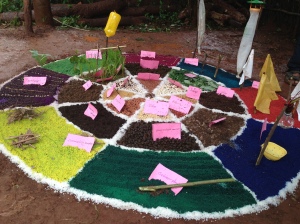As 2015 approaches, so does the target date for the Millennium Development Goals (MDGs). It is undeniable that the MDGs have seen measures of success, if moderate – there has been an increase in primary education around the world, infant mortality has plummeted, and by 2010 the world had already met the goal to halve extreme poverty.
While the Millennium Development Goals have placed importance on community engagement, the gap between supranational goals and basic needs has been difficult to address. To address this gap, the community institutional platform for sustainable agriculture in Andhra Pradesh and Telangana, India was implemented. Creating similar community engagement initiatives in other projects could create sustainable methods of poverty eradication.
Case Study: Community Managed Sustainable Agriculture (CMSA) in Andhra Pradesh and Telangana

Agriculture is a predominant base in the economies of Andhra Pradesh and Telangana and, after the Green Revolution, Andhra Pradesh is one of India’s largest producers of cotton and cereals. However, in the 1990’s crops were failing and agriculture became an expensive and risky occupation. Conventional agricultural methods were labor intensive and required a large investment, often requiring farmers to go into debt to buy pesticides and chemical fertilizers. As farmers used chemical pesticides, the pests started to grow immune and required higher doses of treatment. Farmers were caught in a “pesticide trap”.
In 1995, NGOs such as the Center for Sustainable Agriculture started implementing Non-Pesticide Management to reduce the cost of growing crops and to help farmers get out of debt. Non-Pesticide Management was a system of agriculture that trained farmers in organic methods of eradicating crop pests. The village of Punukula was one of the first to adopt this initiative and, in 2004, saw an increase in both crop yields and profits. From Non-Pesticide Management grew the concept of Community Managed Sustainable Agriculture.
Community Managed Sustainable Agriculture (CMSA) was implemented by the Society for the Elimination of Rural Poverty (SERP) in three phases. The first phase was the creation of an education initiative training farmers in IPM (Integrated Pest Management) technologies – how to observe and understand the behavior and life cycles of crop pests. Farmers learned how to combat pests using physical and biological strategies, such as pheromone traps and bio-pesticides. They then began replacing the chemical pesticides they had previously used with these alternatives. The final stage in CMSA, and the one that separated it from Non-Pesticide Management, addressed issues of soil fertility as farmers gradually replaced conventional chemical fertilizers with composting methods, microbial formulations, and vermiculture (a composting process involving worms).
What has made CMSA so successful has been the community-oriented institutional structure. There are three levels in Community Managed Sustainable Agriculture – Village Organizations (VOs) and Farmer Self Help Groups (SHGs) that allow farmers and community members to collaborate, Sub-District Federations, and District Federations that provide support and assistance. Beyond that, various community based organizations, NGOs, women’s groups, government agencies, and private firms participate in funding and supporting CMSA. After 2005, the World Bank also invested in CMSA, enabling them to expand.

Photo Courtesy of Dr. Vivek Prasad, George Mason University
Upscaling
With input costs low and profit potential relatively high, farmers had more flexibility to experiment. When they found a specific practice or technology successful, they would collaborate with other farmers and, eventually, technical specialists to create a plan to standardize it. Farmers would then create a micro-plan to present to a commercial bank and, due to CMSA’s reliable framework, investors were willing to participate. Seeing this success, the national government implemented similar structures, emphasizing the inclusion of the Poorest of Poor households and women. Organizations throughout India and other countries, encouraged by this success, introduced their own initiatives – Pro Africa has implemented CMSA projects combined with irrigation in South Matabeleland, Zimbabwe.
Implication
Where conventional agriculture was labor intensive, organic agriculture and non-pesticide management was knowledge intensive, requiring comprehensive community-based institutions and means of knowledge transfer. As this knowledge was transferred, the low input and investment costs created access for the poorest in the region to begin working in agriculture. Farmers who had previously gone into debt were able to profit and reduce their debts. Farmers were also able to tap into the organic and pesticide-free markets, drawing higher prices for goods and, thus, higher profits.
CMSA addressed the causes of environmental vulnerability while adapting methods to benefit the people and the environment. Pesticide-related health concerns dropped and there was a 7-9% state-wide reduction in pesticide use. Even gender inequality was confronted – as women became involved through women’s-only SHGs, understandings of gender roles changed and women became active in leadership.
While the MDGs have taken the first step, implementing structures like CMSA in the post-2015 plan would create a more thorough understanding of needs and how to address them. Going beyond participation and creating inclusive frameworks not only engages communities, but also creates a sense of ownership and a drive to propagate best practices.
